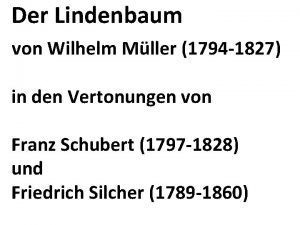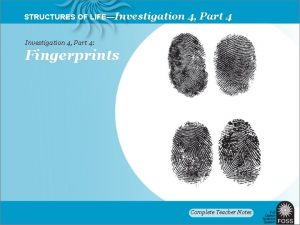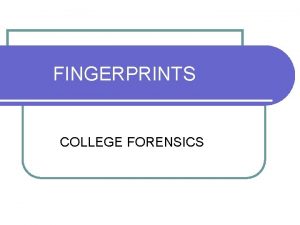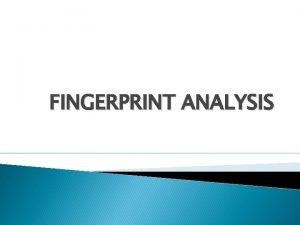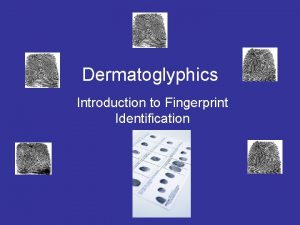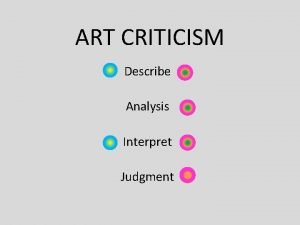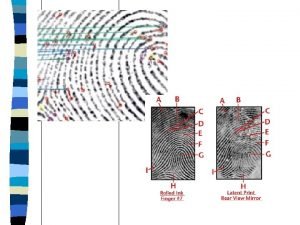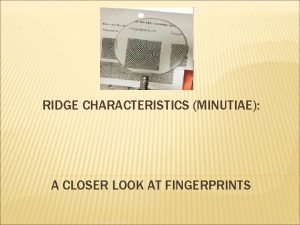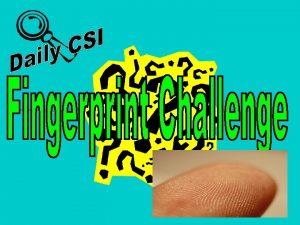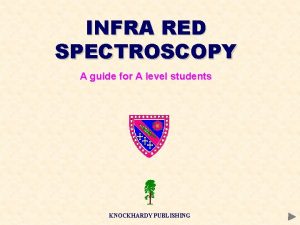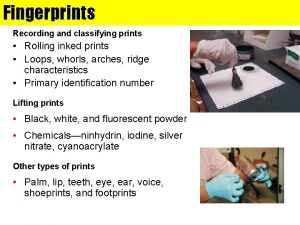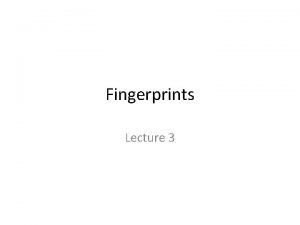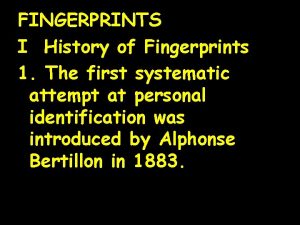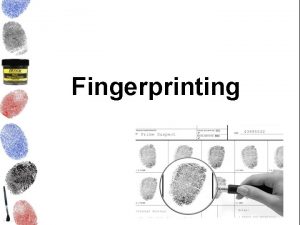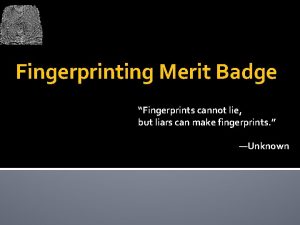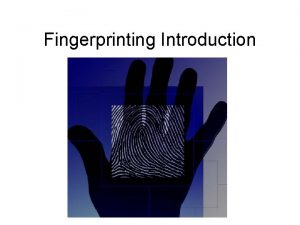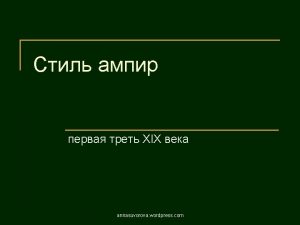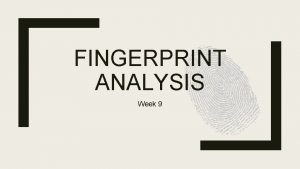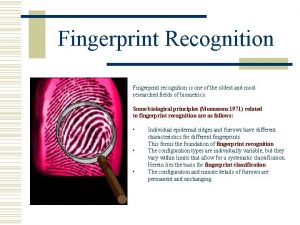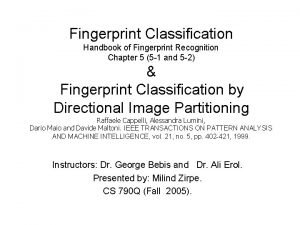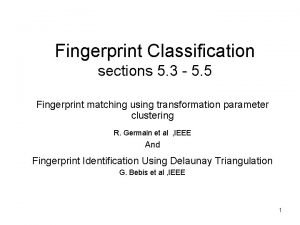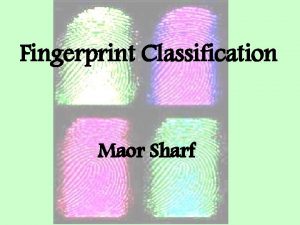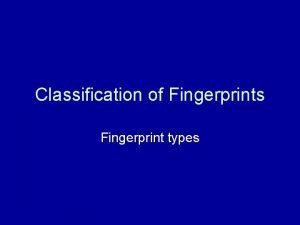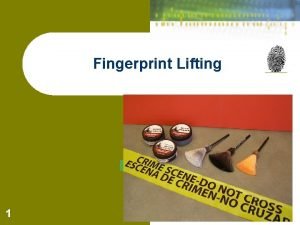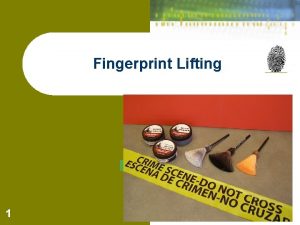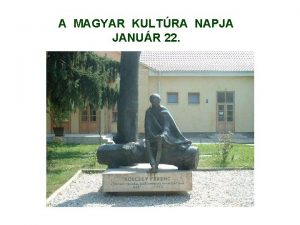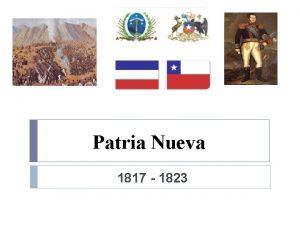FINGERPRINT ANALYSIS HistoryField 1823 description of fingerprint types






























- Slides: 30

FINGERPRINT ANALYSIS

History/Field � 1823: description of fingerprint types is published by Czech physiologist, Jan Evangelist Purkyn � 1858: England is the first country to use fingerprints as a system of criminal identification � 1903: Leavenworth Federal Penitentiary received a prisoner by the name of Will West who had almost the same Bertillon measurements (as well as appearance) as another prisoner currently serving a life sentence for murder; this case ended the use of Bertillon measurements

History/Field (cont. ) � 1975: the FBI introduces the Automated Fingerprint Identification System (AFIS) � Dactyloscopy is the study of fingerprint identification � Fingerprint Examiners are responsible for examining fingerprints

What is a fingerprint? � Skin is composed of two layers: an outer layer called the epidermis and an inner layer called the dermis � The dermis has ridges, called dermal papillae, that project upward into the epidermis to provide friction when picking up an object � The dermis contains sweat and oil glands

What is a fingerprint? (cont. ) � The perspiration, oil, and salts from these glands leave a residue conforming to the pattern of the dermal papillae � The impression left behind is called a fingerprint � The papillae form during fetal life (10 th week) and are unique to every individual; even twins have unique fingerprints

Types of Prints There are 3 types of prints that investigators look for at crime scenes: 1. Patent fingerprints—visible prints transferred onto smooth surfaces by blood or other liquids 2. Plastic fingerprints—indentations left in soft materials such as clay or wax 3. Latent fingerprints—made visible by dusting with powders or the use of chemicals

Collecting Fingerprints � There are two methods for collecting fingerprints: ◦ Dusting ◦ Chemical Fixation

Dusting � Hard surfaces such as glass yield prints when lightly dusted with powder � The powder can be brushed in place with either a camel-hair or fiberglass brush � Care must be taken so as not to brush the print away or add too much powder so that the space between the ridges is filled � Tape can then be used to “lift” the print

Chemical Fixation � Super. Glue—heated Super. Glue will adhere to nonporous substances such as leather or plastic � Ninhydrin—reacts with prints to form a bluepurple color; usually used to lift prints off of paper � Iodine—iodine crystals or heated iodine will produce a purple vapor that will make prints visible but the print will fade so it must be photographed � Silver nitrate—reacts with print so that it can be seen under ultraviolet light

Fingerprint Patterns � There are 3 main fingerprint patterns � These patterns are determined by using deltas � A delta is a “Y” pattern formed by the divergence of ridges � Forensic examiners also look at the Core , which is the center of a whorl or loop, and Ridge count, which is counting from the core to the edge of the delta and distinguishes one fingerprint from another

Example of Core and Delta

Fingerprint Patterns (cont. ) � The patterns are: ◦ Loops: found in 65% of the population and contain one delta ◦ Whorls: found in 30% of the population and contain 2 or more deltas ◦ Arches: found in 5% of the population and have no deltas

Loops �A loop pattern has one or more ridges entering from one side, curving, and then leaving the same side from which it began � Loop can be identified as being either an ulnar loop or a radial loop � Ulnar loops open away from the thumb � Radial loops open toward the thumb Blue Box is Delta

Ulnar and Radial Loops (right hand)

Whorls � Contain 2 deltas and there are several subgroups: ◦ Plain whorl: has two symmetric deltas and a complete circuit; if an imaginary line is drawn between the two deltas, it will touch or cut one of the recurving ridges Blue Boxes are Deltas

Plain whorls

Whorls (cont. ) ◦ Central Pocket Whorl: has two deltas and a complete ridge circuit; the deltas are not symmetric and one side appears to be stretched like elastic; an imaginary line drawn between the deltas will not cross the inner pattern; found in 2% of the population Blue Boxes are Deltas Green circle shows complete circuit

Central Pocket Whorls

Whorls (cont. ) ◦ Double Loop Whorl: has two loops and two deltas; found in 4% of the population Blue Boxes are Deltas

Double Loop Whorls

Whorls (cont. ) ◦ Accidental Whorl: consists of a combination of two different types of patterns, with the exception of the plain arch; it contains two or more deltas; it is a pattern which possesses some of the requirements for two or more different types, or a pattern which conforms to none of the definitions; found in 0. 01% of the population Blue Boxes are Deltas

Accidental Whorls

Arches � Ridges that enter on one side of the finger and cross to the other side while rising upward in the middle � There are 2 subgroups of arches: ◦ Plain arch: the ridges move from one side of the print to the other with no significant changes; found in 4% of the population ◦ Tented arch: arch that appears to have a spike acting as a pole in the middle; found in 1% of the population

Plain Arches

Tented Arches

Identify each fingerprint pattern. DOUBLE LOOP WHORL PLAIN WHORL Left Hand TENTED ARCH RADIAL LOOP Right Hand PLAIN ARCH Right Hand Left Hand

Example of a Ten Card � The Ten Card contains both rolled and plain fingerprints

Individual Ridge Characteristics Use these characteristics as points of identification when comparing fingerprint samples. The more points you can find in common, the better the match!

Ridge Characteristics E L P M A EX Crossover Core Bifurcation (fork) Ridge ending Scar Island Delta Pore http: //cnx. org/content/m 12574/latest/properties. jpg

Practice � http: //www. trutv. com/shows/forensic_files/g ames/fingerprint/index. html
 Ensayos constitucionales de chile entre 1823 y 1830
Ensayos constitucionales de chile entre 1823 y 1830 Patria
Patria Lindenbaum wilhelm müller
Lindenbaum wilhelm müller 1823-1749
1823-1749 Types of fingerprint
Types of fingerprint Radial and ulnar loop
Radial and ulnar loop Fingerprint minutiae types
Fingerprint minutiae types Spiral pattern with 2 deltals and many forms of pattern.
Spiral pattern with 2 deltals and many forms of pattern. 12 ridge characteristics of fingerprints
12 ridge characteristics of fingerprints Dermatoglyphics fingerprint analysis
Dermatoglyphics fingerprint analysis Nociceptive pain
Nociceptive pain Describe analyze interpret judge
Describe analyze interpret judge Job enrichment vs job enlargement
Job enrichment vs job enlargement Art judgement example
Art judgement example Cost analysis requirements description
Cost analysis requirements description Osmisus
Osmisus Different types of ridge characteristics
Different types of ridge characteristics Ridges characteristics
Ridges characteristics Fingerprint cannot be forged justifies the principle of
Fingerprint cannot be forged justifies the principle of What are the two focal points of fingerprints?
What are the two focal points of fingerprints? Fingerprint minutiae
Fingerprint minutiae Ir fingerprint region
Ir fingerprint region Recurving ridge fingerprint
Recurving ridge fingerprint How are fingerprints analyzed?
How are fingerprints analyzed? What is the second fundamental principle of fingerprints
What is the second fundamental principle of fingerprints Patent fingerprints
Patent fingerprints The study of fingerprints
The study of fingerprints Fingerprinting merit badge requirements
Fingerprinting merit badge requirements Principle of fingerprint
Principle of fingerprint Color 09202007
Color 09202007 Fingerprint recognition using matlab project
Fingerprint recognition using matlab project


